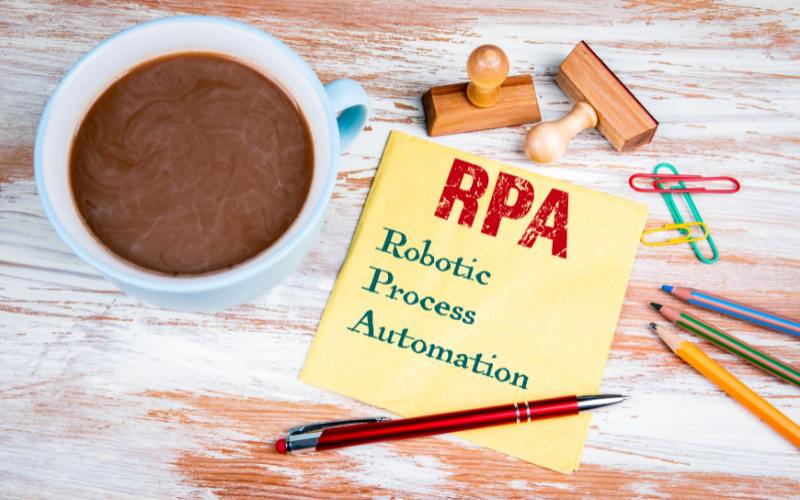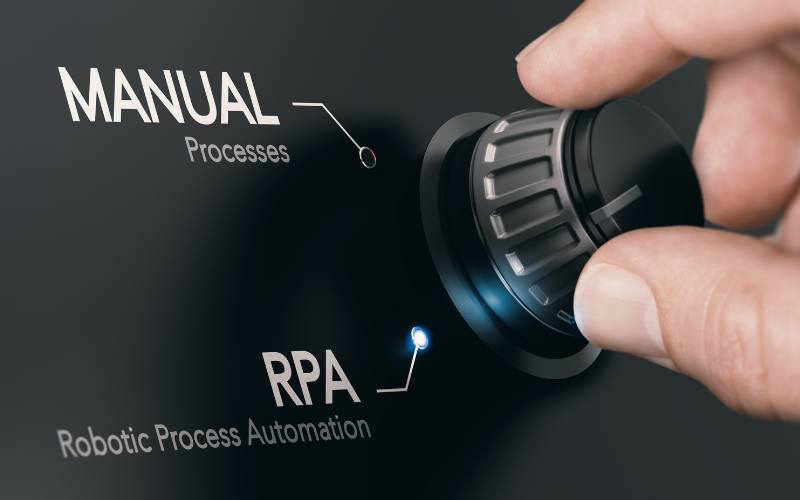Technology can be a wonderful way to add value to your company. It can be utilized in different ways to make your teams and employees work more efficiently and save you money while doing so! A technological approach that can help you to run a business is the one known as Robotic Process Automation.
Below, we will go over Robotic Process Automation in more detail, as well as the myriad of ways that implementing this strategy can help to make strides in your small business and change the way you operate, day to day!
What Is Robotic Process Automation?
The first question that you may have is, what is Robotic Process Automation in the first place? Robotic Process Automation, or RPA, as it is known for short, is the usage of software robots, or bots, to help in automating certain business processes. They do so for the maximum in business cost savings and for increased efficiency. By utilizing RPA tools, companies can transform their organization on a wide scale due to their ability to streamline and organize responsibilities or tasks on a very wide scale. It’s taking their business process management to a new level where RPA software can replace existing systems and automate processes.
RPA bots are designed to mimic the actions of human workers, interacting with applications, databases, and systems just like a human worker would. They can be trained to perform a wide range of tasks and can work 24/7 without the need for breaks or downtime.
RPA is often used in back-office operations, such as finance, accounting, and HR departments, to improve efficiency, reduce errors, and free up human workers to focus on more strategic and value-adding tasks. It is also used in customer service operations, such as chatbots, to provide automated support to customers.

7 Ways Robotic Process Automation Can Transform Your Small Business
Read on to learn more about the top 7 ways that Robotic Process Automation software works for enacting change in small businesses, and how it can be used to help you!
1. Reduce Costs
One of the first things that implementing RPA can do for your business is reduce costs. It is able to reduce costs in a number of ways, some of which are associated with the other benefits of RPA that we will be going over further in this article— like saving time. When a business asks a human team member to complete a task, this costs the company money and can also be affected by errors. There is always the possibility of human error with humans doing the work, but not with the use of RPA and automation! RPA is also a more cost effective option when it comes to certain tasks like data heavy tasks, rather than hiring a full time employee who would work on these tasks.
2. Save Time
As we mentioned above, RPA implementations can also help in your business by saving time. We have all heard the saying that “time is money”! RPA can complete some of the more time intensive tasks that human employees would otherwise have to do themselves. You are able to strategize and have RPA perform tasks so that humans can focus their energy on the ones that still need more of a human touch. By saving time, you are also increasing efficiency in all of the facets of your business that the Robotic Process Automation touches.
3. Reduce Errors
We also touched upon this briefly. RPA software tools can help to reduce errors that may have occurred when humans workers were handling these different, and likely complicated, tasks. While we do want to be understanding of the fact that mistakes can happen, it is also true that there are areas where mistakes just cannot happen— if they do, they can have very serious effects. For instance, if an error were to occur in payroll, billing, or sales, this can have effects that are not easily fixed. It could really affect the bottom line of your small business— and that is the last thing that you need if you want to scale, grow, or simply thrive at the size and stage that you are currently at.
4. Enhance Customer Satisfaction
Customer satisfaction is key to any of the businesses out there, regardless of the industry that you are in. If your customers are unhappy, this is another factor that can affect your bottom line. This is why it is so great that RPA technology is able to help you increase and enhance your customer experience and customer satisfaction. This is one of the many benefits of automation in business. Some of the things that can be automated in this vein, with RPA, include customer service emails, IT tickets, and improving response times to customers on a variety of topics.
5. Improve Employee Retention
Another great thing about Robotic Process Automation is that it can make things easier for your employees and teams. It can improve not only the external customer experience, but the internal employee experience, too. This means that fewer employees will become frustrated or burnt out by the daily tasks required of them, which will also increase your employee retention. Therefore, you will spend less time and resources training new staff! When hiring new staff, the hiring and training costs can be very expensive, so increased employee retention will also save you money. Employees will be able to focus on tasks that engage them, rather than boring and repetitive tasks that can be better handled by RPA bots.
6. Access Advanced Insights
RPA is also able to identify patterns, which can be a valuable tool for your small business. The RPA technology is able to collect and organize data, then automatically run reports for you based on this data. You can even customize your RPA rules, too, meaning that the technology will not pull extraneous information or data that you are not concerned with that could clutter up reports. RPA can then identify different trends that you or other human staff members might have missed when looking at the data your company has collected.
7. Streamline Business Operations
Last, but not least, is that RPA software tools can help to streamline your business operations— and by streamlining your business operations, you can transform your business! RPA is considered to be one of the best and easiest ways to make changes in your business to begin transforming different areas for the better. It can also help to first give you proof of concept before you continue to introduce new changes or initiatives. This is why the implementation of Robotic Process Automation is typically one of the first steps when making changes to or transforming an organization.

Frequently Asked Questions
What is the difference between RPA and Robotic Automation?
RPA (Robotic Process Automation) and robotic automation are often used interchangeably, but they refer to two different types of automation.
Robotic automation, also known as industrial automation, refers to the use of physical robots to automate tasks in manufacturing, logistics, and other industries. These robots are programmed to perform physical tasks such as assembly, packaging, and transportation. They are typically used in industries where there is a high volume of repetitive tasks that require a high degree of accuracy and consistency.
On the other hand, RPA refers to the use of software robots to automate repetitive and rule-based tasks in business processes. These bots interact with applications, databases, and systems just like a human worker would, but without the need for human intervention. They are typically used in industries such as finance, accounting, and HR to automate back-office operations and reduce manual workload.
While both types of automation aim to improve efficiency and reduce errors, they are designed for different types of tasks and industries. Robotic automation is focused on physical tasks, while RPA is focused on automating routine and repetitive tasks performed by human workers.
What are examples of Robotic Process Automation?
Here are some examples of tasks that can be automated using RPA:
- Data entry: RPA bots can be trained to read data from various sources, such as emails, spreadsheets, or PDFs, and input it into the appropriate application or database.
- Invoice processing: RPA bots can be used to automatically extract data from invoices, validate it against pre-defined rules, and create purchase orders or payment requests.
- Report generation: RPA bots can be programmed to generate customized reports by collecting data from various sources and presenting it in a specific format.
- Customer service: RPA bots can be used to provide automated support to customers through chatbots or voice assistants, answering common queries and directing customers to the appropriate resources.
- HR processes: RPA bots can be used to automate HR processes such as employee onboarding, time and attendance tracking, and benefits enrollment.
- Supply chain management: RPA bots can be used to automate supply chain processes such as order processing, inventory management, and shipment tracking.
Overall, any rule-based and repetitive task that requires the manipulation of data across multiple applications or systems can be a good candidate for RPA automation.
FAQ
If you are looking to implement new tools or tech into your business, then chances are that you have heard of Robotic Business Automation, or seen its acronym—- RBA, or also known as Robotic Process Automation RPA. However, you may not fully understand what exactly the term encompasses.
What Is Robotic Business Automation
First things first, what is Robotic Business Automation? This is a type of technology software, also referred to by its acronym of RBA. It is used in many different forms in business, but most commonly for the purpose of automating certain tasks. Robotic Business Automation, by definition, is a technology that helps businesses to build and set up software bots that mimic the interactions and actions of the human staff of a business. They are able to interact with digital systems and software, and can be either internally focused or can be client facing software instead!
Examples of Robotic Business Automation
There are plenty of ways that Robotic Business Automation is implemented into businesses of different sizes, and you may have interacted with some of these client facing examples yourself without realizing it! We will go over the many uses of Robotic Business Automation in greater detail further on in this article, but some common examples of RBA are data entry and data processing bots that can collect information automatically, and other robots and systems that are able to automate different tasks within a business. Client facing bots such as IT help bots or other types of chat bots can also be considered to be a part of Robotic Business Automation.
Benefits of Robotic Business Automation
Now that you are more familiar with what RBA is, you may wonder why it is used. Read on to learn more about some of the key benefits of Robotic Business Automation, and why it is becoming such a popular solution for organizations across all sorts of industries.
Cost Savings
One of the big benefits of Robotic Process Automation is that it can decrease the money spent by a business, therefore RBA offers huge cost savings. It’s been said that the use of robotics can cut operational costs in a business by between 25 to 50%. The use of robots for time consuming tasks can save on man hours that would have otherwise been paid out to your employees, for instance. It also reduces errors in certain areas, which can cost a company money to fix. RBA performing certain tasks can also make it unnecessary for you to hire a full time employee to deal with certain complex or time consuming tasks.
Accuracy and Quality
Typically, RBA offers improvements and services that are targeted and meant to deal with the processes or responsibilities that have a high risk of human error. Therefore, when they are utilized, rather than utilizing human workers, they are able to increase the accuracy of these tasks and the results or conclusions drawn. As we know, robots are reliable and are consistent. They are also able to work without fatigue, unlike people. This means that, even after working on a long or involved task, or by the end of the work day, the quality of RBA work will not deteriorate. All of this helps to decrease the need for re works or re doing certain tasks. In addition to all of this, RBA can increase the capability of a business.
Saves Time and Increases Productivity
Robotic Business Automation technology helps to increase the productivity of a human worker and the business as a whole. This is because the software helps us to save time by having the ability to automate tasks and taking over mundane tasks, repetitive processes and those that are data heavy— which would usually tie up the staff of a company. There is no arguing with the fact that we humans cannot be faster than a machine, after all! With RBA, the bots and the humans being utilized in a company are both able to do what they excel at, which has the direct effect of saving time and increasing productivity across all fronts.
Improved Analytics
Analytics are one of the areas where human error can affect accuracy. We did go over some of the benefits of Robotic Business Automation when it pertains to accuracy above, but improved analytics are another aspect of business that can be affected by using RBA software. This software can be automated to collect information and pull reports, without having to do manual tasks by a human member of the staff. RBA is especially effective for these sorts of data heavy tasks. The software can also be tailored to pull certain information, and not to pull other data that the business is not interested in looking at, for better reporting. Having access to improved reports can also help to make improved business decisions.
Better IT Support
One of the many benefits of implementing Robotic Business Automation software is that it can also help to improve the quality of your IT team and IT support. How does it do this, you may wonder? The RBA software that you set up in your business can help to monitor your network, for example. It may also be able to automate certain help desk responses to get answers to those in need faster, and can create tickets automatically for outstanding issues when IT is contacted. When RBA is used for IT, then it can help to prepare for issues like short term spikes, without meaning that the company needs to hire more staff to account for this.

Uses of Robotic Business Automation
You now know why RBA is used, but it is also important to understand how it is used in business processes, too. Below, we will go over some of the many uses of Robotic Business Automation so that you can determine how it can best be utilized in your own business to benefit you and your team the most.
Payroll
One of the different applications of RBA is in the payroll department. This is a usage of Robotic Business Automation that can be used no matter what industry your business is in. Processing payroll is one of the areas where accuracy is especially key, and any human errors want to be avoided— as they can have a big effect on the bottom line. A RBA solution can be set up to collect relevant information from timesheets and such inputs, then using it to calculate the pay of each employee at the company. Bonuses, expenses, and other factors can be accurately factored in, too.
Website Scraping
Website scraping is one of the steadily growing utilizations of RBA. One of the reasons that Robotic Business Automation is being used for website scraping is because it means there are fewer errors, or is able to eliminate the occurrence of errors entirely. Plus, by using RBA for website scraping, you no longer need to have coding knowledge in order to perform this sort of task. This is a job that would usually be done manually, but an RBA system can now be set up to get it done.
Processing Orders
If you are in the e-commerce or product based business space, processing orders is an important part of your business daily tasks. It directly affects your bottom line, of course, as it is how you are making money, and it is a business process that can be very time consuming! Luckily, business process automation can replace your existing systems and can be used to process your orders instead of having to do it manually. This can also help you to process orders faster and therefore get the product out to your customers quicker. This can improve customer satisfaction and make you more money as well in your business.
Customer Complaints
We never want to have customer complaints, but unfortunately, it is not possible to avoid them completely. In situations like this, it is still possible to turn your customer back into a happy customer, if you are able to satisfy them with your response and also respond quickly. Robotic Business Automation can help you to deal with customer complaints and deliver even better customer service. If you have existing conversations or previous complaints from the customer, the RBA system will also be able to pull these up and refer to them. RBA implementation is also helpful for larger companies that deal with high volumes of customer complaints or communications which can help the overall customer experience.
Credit Card Applications
Last, but not least, is the use of RBA for processing credit card applications. If your business offers a store card, for example, an RBA system can be set up to pull the necessary date for approvals, such as credit reports and background checks. The RBA software robots can then also determine whether or not the application for the card was approved or was denied. This is something that can be instantaneous when done by RBA!

What is robotic process automation in business?
Robotic Process Automation, or RPA, as it is sometimes shortened to, is a type of technology that we see in business— often more than we might think we would see it occurring! Essentially, Robotic Process Automation RPA refers to software technology that make it easier to build and deploy software robots that mimic human interactions to make running your business easier. The continued business process management of these robots, or bots, is also considered to be included as part of RPA software. The bots interact with customers and software, and are able to do a number of different tasks, taking these data heavy or repetitive tasks away from human staff members and being able to automate processes, so that they can better focus their energy elsewhere. An example could be a chat bot that is set up on your website to talk to potential leads and customers.
What are the business applications of robotic process automation?
Robotic Process Automation can be used in business for a variety of different purposes, and it can be used for not only larger businesses and corporations, but for small businesses, too. How is it typically used, you may wonder? RPA can be used in different ways in different industries, too. In finance industries or for finance teams, for example, it may be used for purposes like automating governance, processing invoices, or reconciling accounts. It is typically used for automation, and can automate a variety of tasks to save time for the human members of the team. Some of the business processes that may be automated with RPA include data entry, predictive maintenance, and other high volume or repetitive tasks.
What is robotic business?
Robotic business can be used to refer to the business of making and selling complicated robotics or robotic systems for a variety of different purposes. They can be used in businesses, for consumer use, for industrial use, and more! This term can also be used to refer to the use of robotics in businesses, such as the use and implementation of Robotic Business Automation, or RPA. This is the use of bots or robotic systems (artificial intelligence) that can help make running a business smoother through such things like automating tasks. It has many benefits for the business, including costs savings, saving time and also reducing human errors in data centric or data heavy tasks.
What is an example of robotic process automation?
Robotic Process Automation RPA tools have many benefits in business, and is a great way to save time, money and provide automation solutions— regardless of the industry the company is in, or the size of the company using RPA tools. It can also be utilized in plenty of different ways, and some are better uses of RPA software for others, depending upon the business’ individual needs. One example of Robotic Process Automation in business is in credit card applications, where the RPA bots are programmed to collect the relevant information like credit and background checks. Another example of this RPA software tools is having a chat bot on the company’s website or social media to answer help questions or chat with potential leads and clients, these are all examples of intelligent automation with robotic process automation tools.


